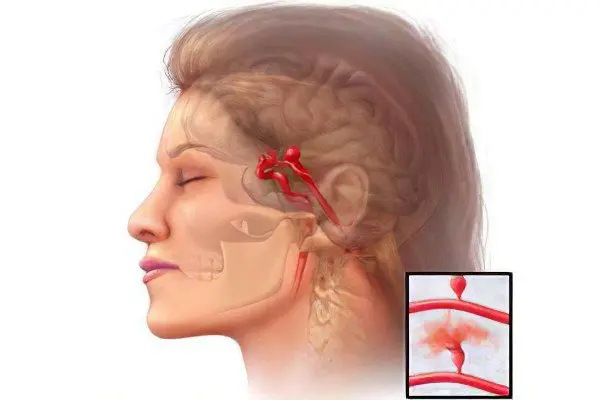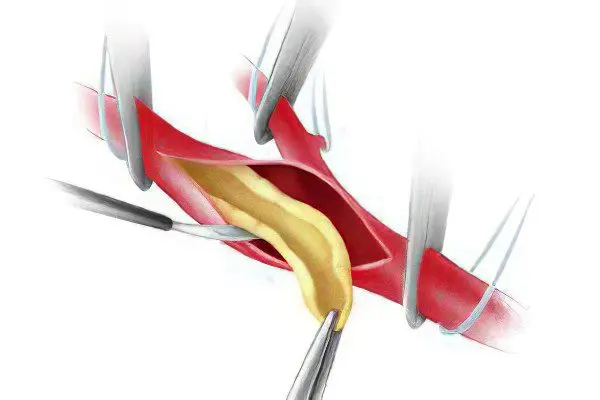Contents
What is carotid atherosclerosis?
Carotid arteries – These are the vessels that feed the organs of the neck and head, including the brain. They are branches of the aorta. Normally, their walls are smooth, without any formations that could interfere with normal blood flow.
The disease, which is characterized by the deposition of plaques in the lumen of the carotid arteries, is called atherosclerosis. These formations are composed of cholesterol, calcium, lipids and connective fibers.
According to statistics, this pathology is observed in most cases in elderly people.
As a rule, the carotid arteries undergo calcification deposits when this process has long been formed in other large vessels. As plaques grow, there is a disruption in the normal blood supply to the brain, which leads to the development of a number of serious diseases. Often this pathological process causes a stroke in a patient.
If the plaque breaks away from the wall of the carotid artery, it enters the bloodstream and is transferred to smaller vessels, which causes blockage and also leads to the development of a stroke.
Symptoms of atherosclerosis of the carotid arteries

In the initial stages, atherosclerosis occurs without the manifestation of vivid symptoms. Often the diagnosis of this disease occurs when a stroke is already a fact. However, there are a number of signs, paying attention to which, you will be able to notice the pathology in time and carry out drug therapy.
At an early stage, atherosclerosis is characterized by periodic transient ischemic attacks. Their duration can be different: from several minutes to 1 hour. At this time, the patient may feel tingling or itching in one half of the body, often such a symptom occurs in the upper or lower limb. There is also a feeling of numbness, weakness, inseparable speech, sometimes there is blindness in one eye and loss of control over the limb.
In some cases, manifestations of a transient attack can last up to 24 hours. Even with a single occurrence of such a condition, you should contact a specialist for diagnosis. Only in this way can the disease be detected in time and treated in order to prevent the development of more serious pathologies.
Note that in rare cases, such symptoms can also characterize the development of a stroke. So do not delay in contacting a medical institution.
Causes of the disease
The occurrence of atherosclerotic calcifications in the carotid arteries occurs for the same reasons as in other vessels.
They include:
Bad habits: drinking alcohol, smoking.
Hypertonic disease.
Endocrine pathologies.
Violation of lipid metabolism.
Overweight.
Wrong diet.
Наследственность.
Frequent stress.
Sedentary lifestyle.
Transferred infections.
Decreased immunity.
Only in rare cases, the disease develops against the background of an aneurysm of the carotid arteries or fibromuscular dysplasia.
Diagnostics
To establish this diagnosis, it is necessary to conduct a thorough examination of the patient. They begin with the clarification of complaints and the collection of anamnestic data. Risk factors must be taken into account. After that, go directly to the inspection.
The doctor conducts auscultation of the carotid arteries, in which vortex flows can be heard. Such a sign occurs when the lumen of the vessels narrows, which is characteristic of atherosclerosis. They also measure blood pressure.
Necessarily, if atherosclerosis is suspected, an ultrasound Doppler study is prescribed. It allows you to determine the structure of the vessels and the nature of the blood flow in them. This is an absolutely painless method with which it is possible to accurately establish the diagnosis.
If the above diagnostic methods leave the doctor with some doubts, the following studies are prescribed:
CT It makes it possible to determine the structure of the carotid arteries after the introduction of a contrast agent and their exposure to X-rays.
MRI. Allows you to see the blood flow and the structure of blood vessels.
Angiography. Requires mandatory use of a radiopaque agent. With its introduction, there is a risk of plaque detachment, which can cause stroke and ischemia. As a result, this method is rarely used.
Treatment of atherosclerosis of the carotid arteries

You need to start treatment with the normalization of lifestyle. First of all, it is necessary to abandon bad habits, if possible, increase physical activity.
Therapy for atherosclerosis of the carotid arteries requires dietary adjustments. The Mediterranean diet is not recommended, which reduces the risk of complications (heart attack, stroke) by more than 50%.
Medication
From medications, drugs are used that reduce the level of cholesterol concentration in the blood: statins and fibrates, and in addition to them, omega-3.
Of the modern cholesterol-lowering agents, it is possible to use Ezetimibe-SZ and Kumaba, which inhibit the activity of a specific carrier protein, without which dietary cholesterol cannot be absorbed.
To prevent the formation of blood clots, and as a consequence of their complications – heart attack or stroke, anticoagulants are prescribed.
Surgery
With advanced forms of the disease, the question of surgical treatment is raised:
Carotid endarterectomy. It is performed under local or general anesthesia. After a small incision, the plaque is removed, which narrows the lumen of the artery and disrupts blood flow.
Stenting and balloon angioplasty. This is a new method. It is carried out under local anesthesia. Used when the previous method of treatment is contraindicated.
Atherosclerosis of the carotid arteries is the last to appear, when a similar process has already affected other large vessels. Therefore, it is worth treating this pathology in time to prevent its spread to other arteries.









